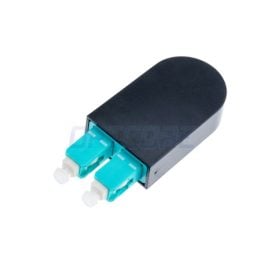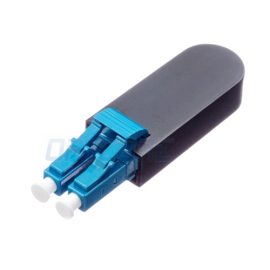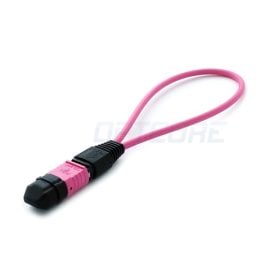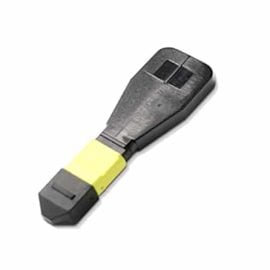Blog, Optical Networking
Loopback Cable: What It Is & How to Use It
Initial Published: September 24, 2024
Network experts must perform various tests to ensure our network equipment performs well. Loopback cables are a testing tool that provides a simple and effective way to reduce the testing burden for test engineers.
This guide describes the definition of loopback cable, the available types, their advantages and disadvantages, and how to choose the right cable for your tests to get the most accurate results. We hope you find this guide helpful.
Table of contents
What are loopback cables?
A loopback cable (also known as a loopback plug or loopback adapter) is a diagnostic tool that tests the functionality of physical ports in network devices.
A loop cable simulates a network connection. Please insert it into the port to perform loopback testing. Loopback cables come in various port versions, including serial ports, Ethernet ports, and wide-area network connections. The connector on the looped cable corresponds to the tested interface.
It can redirect the outgoing electronic signals and digital data streams to the source as input data. This means the sender and receiver are on the same port, and the data never leaves the device but circulates within it. This loopback transmission allows network engineers to test ports’ performance and functionality without connecting to other devices or networks.
Types of loopback cables

Fiber optic loopback cable
A fiber optic loopback cable tests fiber optic equipment and connections. It typically includes two fiber optic connectors, one inserted into the device’s output port and the other into the input port.
This type can be classified according to its connector type, such as LC, SC, FC, MTRJ, and MPO, to meet the connection testing needs of different devices. In addition, they can be divided into single-mode fiber loopback and multi-mode fiber loopback to meet other fiber transmission requirements.
Fiber optic loopback adapters comply with international standards such as IEC, TIA/EIA, NTT, and JIS specifications.
RJ45 loopback cable
The RJ45 loopback adapter is a portable tool for testing Ethernet connections. You can insert the RJ45 loopback plug into the RJ45 jack you want to test and watch the link LED on the switch. If the LED is active, the connection will function properly.
Serial port loopback cable
They are designed to test serial ports such as RS-232 or RS-485, primarily used to connect devices such as modems and routers.
Video port loopback cable
Video port loopback adapters test devices and connections like HDMI, Display Port, and VGA. These cables allow users to verify video signals’ quality, resolution, and color accuracy to ensure optimal device performance.
Steps for using a loopback module
#1. Understand your testing needs
Understanding the test requirements is the first step in the testing process. Before selecting the appropriate loopback cable, you must determine the type of equipment to be tested, the type of ports, and the performance metrics to verify.
#2. Select the appropriate cable
Choosing the suitable loopback cable is critical to your testing, and these are some of the factors you need to consider:
- Port type: To minimize interference and ensure a reliable connection, choose a loopback cable that matches the port type of the network device to be tested. For example, use single-mode fiber optic loopback adapters for single-mode fiber connection and testing and use an MPO connector-type loopback plug to test MOP connector-type fibers.
- Speed and Bandwidth: Speed and bandwidth are the key factors to consider when selecting a loopback cable. Ensuring that the speed and bandwidth are compatible will yield the best test performance, especially when testing the performance of high-speed network connections.
- Connection Type: Ensure that the loopback cable matches the type of connection to the device directly or indirectly through an adapter.
- Protocol compatibility: Ensuring that the loopback cable is compatible with the network protocols used will help improve test and diagnostic accuracy.
#3. Plug in the loopback cable
Plug the selected loopback adapter into the device port you want to test. Ensure it is inserted correctly so data can be smoothly looped back to the same port.
#4. Performing test
Activate your test software or tool. It will send a data stream to the port connected to the loopback cable. The loopback feature ensures that data is returned to the same port without having to exit the device.
#5. Troubleshooting with loopback
If a problem occurs, use the loopback plug for diagnostics. Testing individual ports to identify the problem’s source can help troubleshoot.
#6. Remove loopback cable
After testing, disconnect the loopback cable to resume regular data transmission.
Application scenarios for loopback cables
There are many scenarios where loopback cables can be used for network testing and troubleshooting. The following are some of the primary uses:
- Port testing: Network engineers can use loopback adapters to test whether a device’s physical ports work correctly.
- Performance testing: Engineers can evaluate a device’s performance by inserting loopback cables into its ports.
- Troubleshooting: When a network failure occurs, a loopback plug can help engineers determine where the failure occurred. By testing different ports individually, they can quickly decide whether it is a device or network failure.
- Security audit: Network security experts can use loopback adapters to simulate attacks and test the network’s security. This helps identify potential vulnerabilities and weaknesses.
Advantages and disadvantages of loopback plugs
| Advantages | Shortcoming |
| Quick Diagnostics: The loopback plug allows fast, straightforward port testing without additional equipment or complex setups. | Limited testing: The loopback plug only tests the network’s physical layer. While it can confirm a primary connection, it can’t test higher network layers or verify the integrity of data transmission. |
| Cost-effective: They are usually inexpensive compared to other inspection equipment. | Single Purpose: Loopback plugs are used for specific purposes and are limited in use other than network testing and troubleshooting. |
| Portable: Due to its small size and simplicity, the loopback plug is easy to carry and can be used for mobile testing. | Dependency on physical access: Physical access to a device or network port requires a loopback plug. However, loopback plugs may not be suitable for remote testing or troubleshooting. |
FAQ
Q: Can loopback plugs be used to test Gigabit Ethernet connections?
A: Yes, the loopback plug can test Gigabit Ethernet connections.
Q: Where can you buy a loopback cable?
A: You can find them on our official website: OPTCORE. A quick shopping link is below.
-
 Multimode OM3 SC Fiber Loopback ModuleUS$ 3.90 (Excl. VAT)
Multimode OM3 SC Fiber Loopback ModuleUS$ 3.90 (Excl. VAT) -
 Singlemode LC Fiber Loopback ModuleUS$ 3.90 (Excl. VAT)
Singlemode LC Fiber Loopback ModuleUS$ 3.90 (Excl. VAT) -
 Multimode OM4 MPO Female Fiber Loopback Module, 24-FibersUS$ 42.00 (Excl. VAT)
Multimode OM4 MPO Female Fiber Loopback Module, 24-FibersUS$ 42.00 (Excl. VAT) -
 Single Mode OS2 MPO Female Loopback Module, 12-FiberUS$ 45.00 (Excl. VAT)
Single Mode OS2 MPO Female Loopback Module, 12-FiberUS$ 45.00 (Excl. VAT)
Q: Are there video tutorials for how to use the Loopback plug?
A: you can watch video demonstration tutorials on platforms like YouTube. The video demonstrates how to use a loopback plug.
Q: Are LC loopback cables only available in single mode?
A: No, LC loopback cable is also available in 9/125 single-mode fiber, 50/125 multimode fiber, or 62.5/125 multimode fiber.
Conclusion
All in all, Loopback cables are essential for diagnosing and testing network equipment. Selecting the appropriate loopback adapter is the primary condition for ensuring accurate testing and good network performance.
However, as mentioned in the article, Loopback cables also have defects. Their limitations must be considered when testing higher network layers.
Reference







